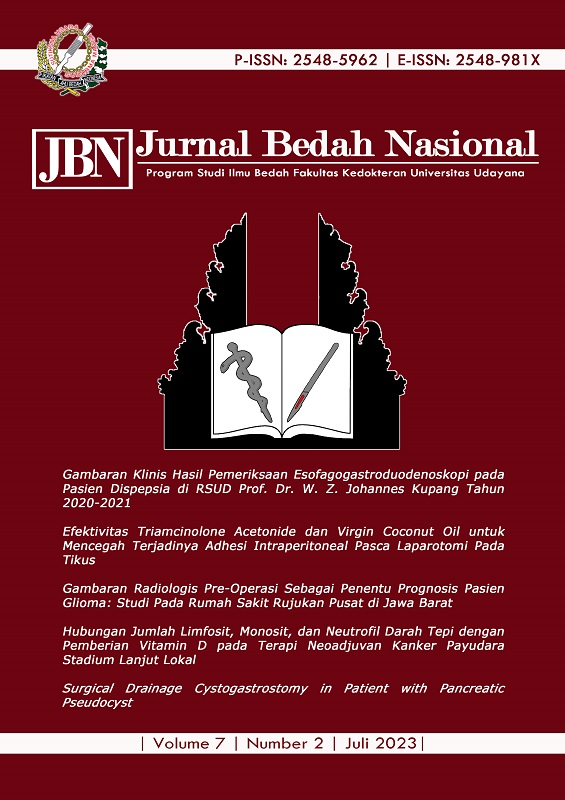Gambaran Radiologis Pre-Operasi Sebagai Penentu Prognosis Pasien Glioma: Studi Pada Rumah Sakit Rujukan Pusat di Jawa Barat
Abstract
Tujuan: Untuk menilai nekrosis tumor, penyengatan zat kontras, dan edema peritumoral pada MRI pre-operasi sebagai prediktor rerata waktu kesintasan pasien glioma derajat rendah dan tinggi. Metode: Penelitian ini menggunakan desain potong lintang retrospektif yang melibatkan 26 pasien glioma derajat rendah (n=11) dan derajat tinggi (n=15) berdasarkan hasil histopatologi pasca operasi. Gambaran radiologi MRI pre-operatif dinilai menggunakan parameter nekrosis, penyengatan zat kontras dan edema peritumoral. Selain itu juga dihitung waktu kesintasan pasien pasca operasi untuk kemudian dianalisis secara statistik angka rerata kesintasan menggunakan analisis Kaplan-Meier. Hasil: Gambaran nekrosis tumor pada MRI pre-operatif memiliki pengaruh yang secara statistik bermakna terhadap rerata waktu kesintasan pasien glioma (p=0,021). Selain itu Karnofsky performance score (KPS) pasca operasi (p=0,050) dan lokasi tumor (p=0,036) juga berpengaruh pada rerata waktu kesintasan pasien glioma. Pasien glioma dalam penelitian ini memiliki rerata waktu kesintasan yang lebih pendek jika memiliki gambran nekrosis derajat II pada MRI pre operatif (14 bulan); rerata waktu kesintasan lebih panjang jika lokasi tumor di lobus oksipital (38 bulan) dan KPS pasca operasi ?70 (28,67 bulan). Kesimpulan: Pemeriksaan radiologis pre-operatif dapat berkontribusi dalam penentuan prognosis pasien glioma. Meski demikian derajat histopatologis dan pemeriksaan molekuler tetap berperan penting dalam penentuan pilihan terapi lanjutan dan prognostik pasien glioma.
Downloads
References
2. Gokturk D, Kelebek H, Ceylan S, dkk. The Effect of Ascorbic Acid Over the Etoposide- and Temozolemide-Mediated Cytotoxicity in Glioblastoma Cell Culture: A Molecular Study. Turk Neurosurg. 2018;28:13-8.
3. Erdi F, Bulent K, Hasan E, dkk. New Clues in the Malignant Progression of Glioblastoma: Can the Thioredoxin System Play a Role? Turk Neurosurg. 2018;28:7-12
4. Kyritsis AP, Bondy ML, Rao JS, dkk. Inherited predisposition to glioma. Neuro-oncology. 2010;12:104-13
5. Ohgaki H, Kleihues P, von Deimling A, dkk. Glioblastoma IDH-mutant. Dalam: Louis DN, Ohgaki H, Wiestler OD, dkk editors. WHO Classification of Tumours of the Central Nervous System Revised. 4th Ed. Lyon: International Agency for Research on Cancer; 2016. hal.52-6.
6. Ostrom QT, Bauchet L, Davis FG, dkk. The epidemiology of glioma in adults: a “state of the science” review. Neuro Oncol. 2014;16:896-913.
7. Fu J, Shu J, Yu X, dkk. Predicting tumor recurrence of astrocytoma by Ki-67 and proton magnetic resonance spectra. Int J Clin Exp Med. 2017;10:11187-96.
8. von Deimling A, Huse JT, Yan H, dkk. Diffuse astrocytoma, IDH-mutant. Dalam: Louis DN, Ohgaki H, Wiestler OD, dkk editors. WHO Classification of Tumours of the Central Nervous System Revised. 4th Ed. Lyon: International Agency for Research on Cancer; 2016. hal.18-23.
9. Mellai M, Piazzi A, Caldera V, dkk. IDH1 and IDH2 mutations, immunohistochemistry and associations in a series of brain tumors. J Neurooncol. 2011;105:345-57.
10. Preusser M, Wohrer A, Stary S, dkk. Value and Limitations of Immunohistochemistry and gene Sequencing for Detection of the IDH1R132H mutation in diffuse Glioma Biopsy Specimens. J Neuropathol Exp Neurol. 2011;70:715-23.
11. Catteau A, Giraldi H, Monville F, dkk. A new sensitive PCR assay for one-step detection of 12 IDH1/2 mutations in glioma. Acta Neuropathol Commun. 2014;2:58.
12. Hammoud MA, Sawaya R, Shi W, dkk. Prognostic significance of preoperative MRI scans in Glioblastoma multiforme. J Neurooncol. 1996;27:65-73.
13. Wu CX, Lin GS, Lin ZX, dkk. Peritumoral edema on magnetic resonance imaging predicts a poor clinical outcome in malignant glioma. Oncol Lett. 2015;10:2769-76.
14. Schoenegger K, Oberndorfer S, Wuschitz B, dkk. Peritumoral edema on MRI at initial diagnosis: an independent prognostic factor for glioblastoma? Eur J Neurol. 2009;16:874-8.
15. Stupp R, Janzer RC, Hegi ME, dkk. Prognostic Factors for Low Grade Gliomas. Semin Oncol. 2003;30(6 Suppl 19):23-8.
16. Buckner JC. Factors influencing survival in high-grade gliomas. Semin Oncol. 2003;30(6 Suppl 19):10-4.
17. Noiphithak R, Veerasarn K. Clinical predictors for survival and treatment outcome of high-grade glioma in Prasat Neurological Institute. Asian J Neurosurg. 2017;12:28-33.
18. Moiyadi AV. Glioma surgery: The art and science. International Journal of Neurooncology. 2018;1:6-10.

This work is licensed under a Creative Commons Attribution 4.0 International License.
Program Studi Ilmu Bedah Fakultas Kedokteran Universitas Udayana. 
This work is licensed under a Creative Commons Attribution 4.0 International License.






